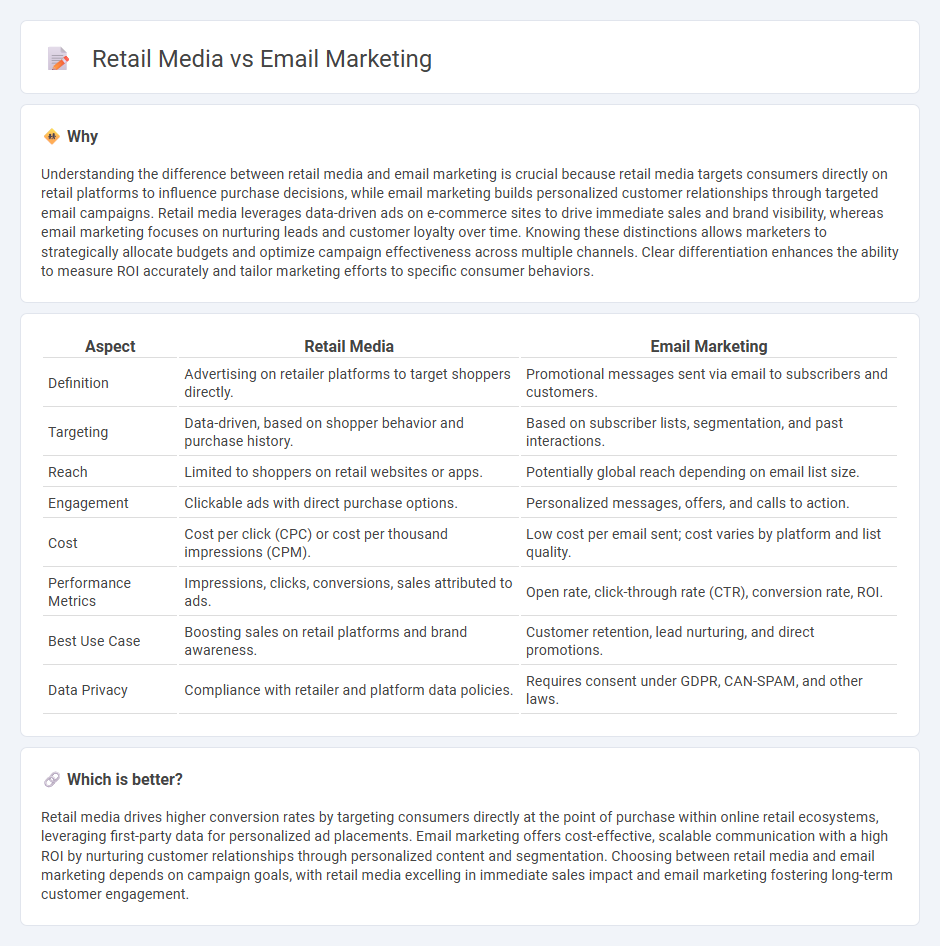
Retail media leverages targeted advertising within e-commerce platforms to reach shoppers at the point of purchase, driving immediate sales through personalized content and product placements. Email marketing focuses on direct communication with consumers by delivering tailored messages, promotions, and updates to nurture relationships and build brand loyalty. Discover how combining retail media and email marketing can maximize customer engagement and boost revenue.
Why it is important
Understanding the difference between retail media and email marketing is crucial because retail media targets consumers directly on retail platforms to influence purchase decisions, while email marketing builds personalized customer relationships through targeted email campaigns. Retail media leverages data-driven ads on e-commerce sites to drive immediate sales and brand visibility, whereas email marketing focuses on nurturing leads and customer loyalty over time. Knowing these distinctions allows marketers to strategically allocate budgets and optimize campaign effectiveness across multiple channels. Clear differentiation enhances the ability to measure ROI accurately and tailor marketing efforts to specific consumer behaviors.
Comparison Table
| Aspect | Retail Media | Email Marketing |
|---|---|---|
| Definition | Advertising on retailer platforms to target shoppers directly. | Promotional messages sent via email to subscribers and customers. |
| Targeting | Data-driven, based on shopper behavior and purchase history. | Based on subscriber lists, segmentation, and past interactions. |
| Reach | Limited to shoppers on retail websites or apps. | Potentially global reach depending on email list size. |
| Engagement | Clickable ads with direct purchase options. | Personalized messages, offers, and calls to action. |
| Cost | Cost per click (CPC) or cost per thousand impressions (CPM). | Low cost per email sent; cost varies by platform and list quality. |
| Performance Metrics | Impressions, clicks, conversions, sales attributed to ads. | Open rate, click-through rate (CTR), conversion rate, ROI. |
| Best Use Case | Boosting sales on retail platforms and brand awareness. | Customer retention, lead nurturing, and direct promotions. |
| Data Privacy | Compliance with retailer and platform data policies. | Requires consent under GDPR, CAN-SPAM, and other laws. |
Which is better?
Retail media drives higher conversion rates by targeting consumers directly at the point of purchase within online retail ecosystems, leveraging first-party data for personalized ad placements. Email marketing offers cost-effective, scalable communication with a high ROI by nurturing customer relationships through personalized content and segmentation. Choosing between retail media and email marketing depends on campaign goals, with retail media excelling in immediate sales impact and email marketing fostering long-term customer engagement.
Connection
Retail media leverages shopper data and purchase behaviors to deliver targeted advertising directly on retail platforms, driving immediate consumer engagement. Email marketing complements this by nurturing customer relationships with personalized offers and product recommendations based on retail media insights. Together, they create a seamless omnichannel strategy that boosts conversion rates and maximizes return on ad spend (ROAS).
Key Terms
Open Rate
Email marketing achieves an average open rate of around 21.33%, making it a direct and measurable channel for customer engagement. Retail media, leveraging targeted ads on retail platforms, often yields higher visibility but lacks the precise open rate metrics that email campaigns provide. Discover how comparing open rates can optimize your marketing strategy and maximize ROI.
Click-Through Rate (CTR)
Email marketing achieves an average click-through rate (CTR) of approximately 2.5%, driven by personalized content and targeted campaigns. Retail media, leveraging product placement and shopper intent within e-commerce platforms, often surpasses traditional channels with CTRs ranging from 3% to 10%. Discover how optimizing these channels can maximize engagement and boost conversion rates effectively.
Onsite Display Ads
Onsite display ads in retail media directly target shoppers during their browsing experience, leveraging real-time data to boost product visibility and conversion rates. Email marketing, conversely, utilizes personalized messages to engage customers offsite, driving traffic through tailored offers and content. Explore our detailed analysis to discover which strategy best suits your business goals.
Source and External Links
What is Email Marketing? [An Expert Guide for Beginners] - Email marketing is a type of digital marketing that involves using email to attract, engage, and communicate with potential and existing customers by building an active email list, using an Email Service Provider, and setting clear campaign goals.
Email marketing -- a step-by-step guide to getting started - Effective email marketing involves defining your audience, setting goals, choosing an email platform, building and segmenting your email list, creating targeted campaigns, testing them, and measuring results to improve engagement and ROI.
What Is Email Marketing? - Email marketing is a digital strategy to connect with potential customers, build loyalty, raise brand awareness, and promote products via personalized emails like welcome messages, newsletters, promotions, lead nurturing, and transactional emails.
 dowidth.com
dowidth.com